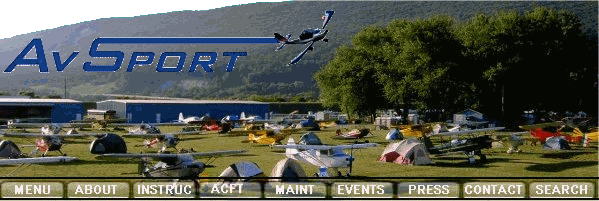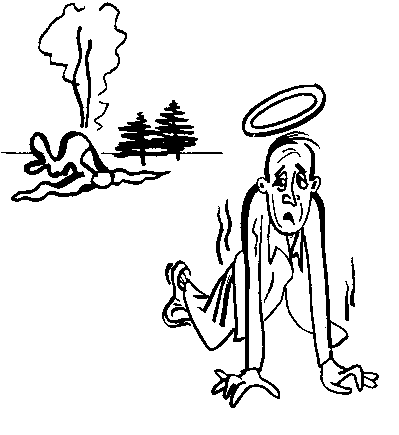
AvSport of Lock Haven -- 353 Proctor Street, Lock Haven PA 17745
Crosswind Arrival
Excerpt from Winging It! With Dr. Paul: Forty Tales Your Flight Instructor Never Told You (copyright © 1989 by H. Paul Shuch)

Crosswind Arrival
Excerpt from Winging It! With Dr. Paul: Forty Tales Your Flight Instructor Never Told You (copyright © 1989 by H. Paul Shuch)
"Go around!" I commanded just as the upwind wing started to rise, and Mike proceeded to do precisely that. Around 90 degrees, right there on the runway, with a squealing of tires and a gnashing of teeth and a shearing of nose strut, a scraping of wingtip and pounding of pavement as the prop blades bit hard. And then we were stopped. Nosed over on the runway, a mangled crosswind tetrahedron. "Fuel selector off, mixture idle cutoff, mags off, all switches off," I yelled as I swung the door free and scrambled out of the Cherokee. Mike was right behind me; so was a Cessna in the pattern. That craft's go-around was somewhat more graceful than our own. "Well," panted Mike when well clear of the wreckage, "I guess I flunked my Biennial."
 How had I let myself get suckered into this, my first true accident in twenty five years of flying? By totally relinquishing control - the one sin for which a flight instructor can never gain absolution. But there were extenuating circumstances, I told my confessor at the Flight Standards District Office.
How had I let myself get suckered into this, my first true accident in twenty five years of flying? By totally relinquishing control - the one sin for which a flight instructor can never gain absolution. But there were extenuating circumstances, I told my confessor at the Flight Standards District Office.
Mike was an experienced private pilot, been flying as long as I, and had owned this elderly Cherokee since new. I was administering a Biennial Flight Review, a recurrency training requirement imposed upon all aviators from private pilot to airline captain. Since we had flown together without incident on four prior occasions, I had no reason whatever to doubt this pilot's competence.
A one hour cross country flight had gone extremely well. Though perhaps a bit rusty, Mike had flown with precision, holding altitudes and headings to acceptable limits. He had requested and received clearances through the Oakland Airport Radar Service Area, and the San Francisco Terminal Control Area. I could find no fault with his clearance requests or compliance. He successfully located the unfamiliar field which was our day's destination, and overflew the pattern to study the wind sock. He correctly identified the preferred runway; we both noted a significant left crosswind. Well within the capabilities of both aircraft and pilot, I assessed.
There are two popular strategies to a successful crosswind landing, and it's anybody's guess which is the better. Rolling out on final leg of a standard traffic pattern, I reminded Mike of my favored technique: "Let's get that slip in there. Left wing down, and right rudder, now." He replied "I prefer to crab on final," and set up an acceptable wings-level angled approach, perfectly tracking the runway centerline. Fine, I thought, it's his airplane.
The flight instructor walks a peculiar tightrope. In a flight review, he is supposed to let the Pilot in Command fly the plane and demonstrate proficiency. He should not interfere with the operation of the craft. On the other hand, he is not supposed to let the pilot bend an airplane. At what point do you usurp the pilot's authority? How long do you wait?
Not as long as I did. When the left wing started to come up in the flare, I failed to take control of the craft. In truth, my hand wasn't even on the yoke, my feet not even on the rudder pedals. Mike was the Pilot in Command, I the disinterested and detached observer. At no time during the flight review had I seen any action which suggested questioning his ability to handle the prevailing conditions. Besides, I had seen Mike land in crosswinds worse than this; he knew what he was doing!
By the time the nose started to yaw into the wind, and I commanded the go-around, it was too late. The results of my inattention were a sheared nose strut, a crushed lower cowling, a prop strike and pulverized wing tip, and blemished records for us both. It could have been much worse.
Of course, I told the FAA investigators when they called me in for reexamination of my flight instructor's credentials. Of course I should have taken over control of the aircraft the instant the upwind wing began to rise. But if a CFI never lets his BFR candidates make decisions for themselves, if he never lets them land the plane, how can he certify their competence as PIC?
Haven't you always heard it's impossible to groundloop with a tricycle landing gear? So had I! As an old taildragger pilot (whether that's pilot flying old taildraggers, or old pilot flying taildraggers, I leave for you to decide), I suppose I was seduced into complacency by the docile nose wheel. Had this been a conventional landing gear, I insisted to the FAA, I'd have been much more cautious.
Lesson learned: from now on, I fly trikes just as though they were taildraggers, and teach my students to do the same.
I was relieved to learn the FAA plans no enforcement action against Mike. He's been punished enough, the examiner told me. "You mean because he has to pay for the repairs?" I asked.
"No, because he has to explain them to his wife."

If you can drive, you can fly!
Copyright © AvSport of Lock Haven, a subsidiary of Microcomm Consulting This page last updated 1 June 2010 |
Top of Page |